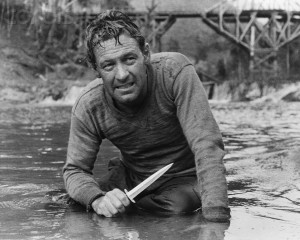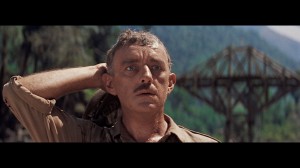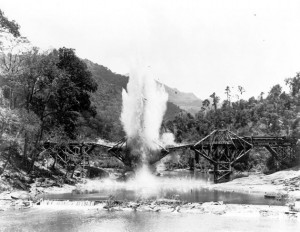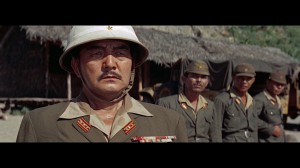100 Film Favorites – #40: The Bridge on the River Kwai
(David Lean, 1957)
Just call me suburbanization, ‘cuz I’m at the end of the ’40s.
And now, for our 61st post, a film in which Obi-Wan Kenobi builds a bridge for the pirate king from Disney’s Swiss Family Robinson.
![]()
The Bridge on the River Kwai is set primarily in a Japanese P.O.W. camp in the Burmese jungle during World War II. The film opens with a company of British prisoners being marched into the camp, defiantly whistling the “Colonel Bogey March” despite their bedraggled appearance. The commandant of the camp, Colonel Saito (Sessue Hayakawa) tells the assembled prisoners that they all will be made to do manual labor to aid the Japanese war effort. The British commanding officer, Lt. Colonel Nicholson (Alec Guinness) objects to this, stating that the Geneva Conventions dictate that officers cannot be forced to do manual labor. When Nicholson and his officers fail to report to work the next morning, Saito disciplines them, locking Nicholson in “the oven,” a metal hot-box. But the British soldiers do not relent in their respect and obedience toward Nicholson, and Saito eventually gives in to his demands: Officers will no longer be forced to toil alongside their men. As a weakened and very sweaty Nicholson staggers out of the hot-box, his soldiers give a reverent salute.
The main project for which Saito is responsible is the construction of…can you guess? That’s right, a bridge over the River Kwai! This bridge will be part of the Burma Railway, used to transport Japanese troops and equipment far into mainland Asia. The British soldiers, along with American, Australian, and other assorted P.O.W.s are tasked with the bridge-building grunt work. Initially, the prisoners do all they can to delay, if not outright sabotage, the project, deliberately employing shoddy building methods.
Nicholson, however, comes to respect Saito, who confides that if the bridge is not completed he will be obliged to kill himself via seppuku. More importantly, Nicholson views the construction project as a symbol of British work ethic, and a potent tool for building morale among his men. Nicholson orders his soldiers to build the bridge properly, going so far as to command two of his men with engineering experience to advise the Japanese engineers on a more advantageous and sturdy spot to position the bridge. Though some of the prisoners object to the plan at first, considering it collaboration with the enemy, Nicholson talks them into building a bridge which will stand for many years as a testament to British ingenuity and hard work.
This transition, to me, is the most intriguing aspect of the film. Nicholson’s likeability and confidence encourages the audience to go along with and support him and his plans…even once those plans start to enter a gray area of legality and morality. Despite championing British strength, Nicholson is directly aiding the Japanese to the best of his abilities. It gets to the point where he even goes back on an earlier order, directing his officers to pitch in to ensure the bridge’s timely completion. And yet, his charm and confidence still had me rooting for him. The first time I began to realize the questionable nature of his actions was when Nicholson orders even his wounded and bedridden soldiers to shuffle off to work at the bridge site, marching past the prison cemetery this sudden labor may soon consign them to.
Meanwhile, as the building project is underway, an American P.O.W. named Commander Shears has escaped the camp and returned to safety after receiving help from sympathetic Burmese natives. Shears’ superiors order him to lead a commando mission to return to Saito’s camp and destroy the bridge before it can reach completion.
The Japanese government has received word of the superior nature of the bridge’s construction, and thus decides to make its opening a grand spectacle, with the first train to cross the bridge scheduled to carry both soldiers and dignitaries. Shears plans to schedule the bridge’s destruction to coincide with the arrival of the train, intending to kill two birds with one stone. However, on the day of the “grand opening,” Nicholson catches Shears setting explosive charges around the bridge supports. He warns Saito, and the two rush down the river bank to confront Shears. In the ensuing shootout, both Shears and Saito are killed, and Nicholson is mortally wounded. Seeing his fellow prisoners dying, and finally realizing the sinister effects of his collaboration, Nicholson exclaims “What have I done?” He then collapses, dead, on the detonator’s plunger. The bridge is obliterated in a massive explosion, and the train full of people (including many triumphant P.O.W.s) plummets into the river below.
As I mentioned, I find this film to be particularly powerful because it features a protagonist whose motives and actions gradually shift into questionable territory. We find ourselves rooting for Nicholson both because of the gradual nature of his arc and simply because that’s “what you do” for protagonists. It’s surprising to have the main character of a film transition from an apparently noble and capable leader to a dangerous collaborator who fails to consider the consequences of his actions. I have to admit that when I first saw the film, I didn’t expect the abrupt “everybody dies” ending. But, as in the stage version of Little Shop of Horrors, it’s a logical conclusion of Nicholson’s arc. He went too far in his pursuit of questionable goals, and as a result he and those around him suffer.
The film’s success also results from the strength of its performances. Alec Guinness is impressive and inspiring, even when committing questionable deeds, and Sessue Hayakawa gives a human face to the Japanese enemy in his sympathetic portrayal of Colonel Saito.
Finally, perhaps the most iconic and widely-known feature of this film is the opening music, a whistled rendition of the “Colonel Bogey March.” The march provided the tune for a well-known British marching song sung during WWII, “Hitler Has Only Got One Ball.” The lyrics were considered too vulgar to be heard in the film, but the public was familiar enough with the song for the soldiers’ whistling to evoke its words in audiences’ minds. The song goes as follows:
“Hitler – has only got one ball!
Goering – has two, but very small!
Himmler – is very sim’lar,
and Goebbels – has no balls, at all!”
The movie was based on Pierre Boulle’s novel The Bridge Over the River Kwai, and has been widely regarded as a classic since its release. At the 30th Academy Awards, the film received 7 Oscars, including Best Picture, Best Director, Best Actor for Alec Guinness, Best Cinematography, Best Score, Best Adapted Screenplay, and Best Editing. It’s a powerful film with a complex protagonist, and depicts human characters on both sides of history’s greatest war. Unlike some of the selections on this list, this is one film which gets the seal of approval from even the most legitimate of critics.
Tidbits:
The film’s story is largely fictional, though P.O.W.s really were forced to construct the Burma Railway, a project which included the construction of several bridges and which saw thousands of laborers lose their lives.
P.S. On the original Brian Terrill Movie Night Facebook page, this was the post in which I first announced I would be moving the Countdown to Earn This! Now, sixty days later, the full Countdown still is not complete on BTMN…largely due to the extra time spent re-purposing posts for this site. I promise you’ll see the final entries soon enough.
—
Brian Terrill is the host of television show Count Gauntly’s Horrors from the Public Domain. You can keep up with Brian’s 100 Film Favorites countdown here.












